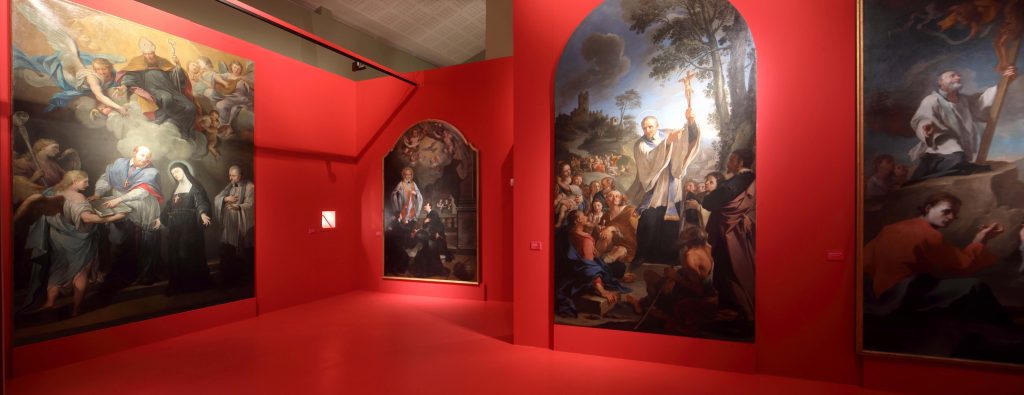
The beauty of art: a way to tell the story of the Vincentian charism
The story of our Vincentian charism (which last year was celebrated in a very significant manner since it marked the 400th anniversary of its origin) can be told not only through conferences and other specialized studies but can also be told by exploring the different works of art which depict our Founder. Such an exploration provided us with an opportunity to engage in a rather complete study of the Vincentian iconography in Italy (between the seventeenth century and the twentieth century). Thus, in the school of Alberoni de Piacenza, an exhibition entitled The colors of charity, took place between December 15, 2017 – February 25, 2018.
The exhibition was held in the Hall of Tapestries and was painted red, thus creating the impression that the visitors were entering into the heart of Saint Vincent’s charity. In fact, the exhibits were arranged in the form of two inverted U’s which were then interlaced with each other from the inside … thus creating two large compartments which represented two chambers of the heart. Large round altarpieces (focused on the Vincentian charism) were placed on the walls.
The first area was dedicated to the theme of Vincent’s preaching. There one was able to contemplate the beatification (1729) by Aureliano Milani; a piece from the Galleria Corsini de Giacomo Zoboli that was done at the time of Vincent’s canonization (1737), a piece by Giuseppe Antonio Petrini (1748-1750), another by Vittorio Amedeo Rapous (1776). The second area was dedicated to the friendship between Vincent and Francis de Sales and there one could view pieces by Sebastino Conca, the vision of the three globes (1751) and by Francesco Vellani, a piece in which Francis is offering Vincent the place of superior in the Visitation Monastery in Paris.
The next area was focused on the theme of charity and there one saw a large canvas by the artist Givvanni Carobbio which depicts Vincent sending forth the first missionaries and, in the background, two Daughters of Charity can be seen caring for a sick person. On the outer walls were placed paintings that depicted: the establishment of the Congregation with the presence of Madame de Gondi and another by Antonio and Ubaldo Ricci where Vincent is pictured instructing the Daughters and the Ladies of Charity about using money for the poor. The most valued painting was that of Mauro Conconi which was discovered in the Chamber of Deputies in Rome … the Academy of Fine Arts in Bologna presented Mauro with the first prize for this artistic work (1841), a canvas that depicts Vincent exhorting the Ladies of Charity in Paris to take up the work of the foundlings.
Two other rooms were also used for this exhibition and one room contained five portraits of St. Vincent (these five were selected from among the more than 200 that have been exhibited throughout Italy. Among these were the paintings by Adeodato Malatesta and another by Alessandro Calvi. In the same room were four large ovals painted by Michele Antonio Milocco on the occasion of Vincent’s beatification and another by Guglielmo De Sanctis which depicts Vincent instructing the participants in a Tuesday Conference (present for that conference were Cardinal Richelieu and Cardinal Mazarin). Pope Pius IX, wishing to thank the Congregation for their ministry on behalf of the clergy, gifted the missionaries in Rome with this painting.
In the other room was a canvas by Luigi Crespi in which Vincent is seen venerating the Virgin who is enthroned. On the walls to the left was a series of painting by Rodolfo Morgari or Salvatore Monosilio and on the right were originals of Antoine Hérisset that were done at the time of Vincent’s beatification (these became the vehicle that was used to spread devotion to Vincent during an era in which photography did not exist).
In the hallway between the two rooms one could see Vincent’s hat, cassock, cape and sandals (these were provided by the House in Turin). Here was also a reproduction of a fresco by Aurelio Galeppini (the illustrator of Tex Willer, the famous Italian cowboy hero).
As one walked through this exhibit one was able to contemplate Vincent through the eyes of many various Italian artists which translated their feelings of gratitude and inspiration into incredible works of art. Each painting is not simply a reproduction of some event but is a transfiguration of those events, a transfiguration in the form of artistic beauty, a transfiguration that touches the viewers and instills in them a desire to give new life to that charism.
As a result of the catalogue that was prepared for this event, the exhibition will live on into the future. The catalogue contains photos not only of the works that were exhibited but also contains images of the important works that could be catalogued and photographed. The reproduction of these images is high quality and can therefore be viewed and admired and contemplated by those persons who were unable to view the exhibition in person.
By Erminio Antonello, CM
Italian Province
Translated: Charles T. Plock, CM







Beautiful videos of the exhibit at https://www.facebook.com/galleria.alberoni/videos/1785776588392122/ and here https://www.facebook.com/galleria.alberoni/videos/1782249935411454/
Thank you very much!